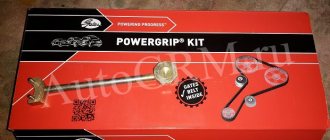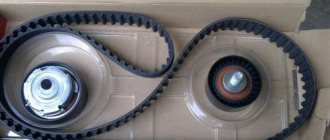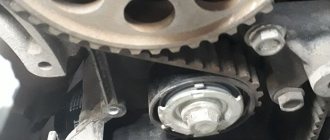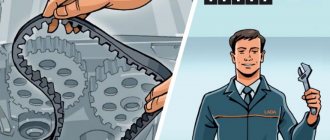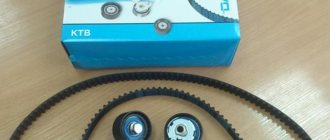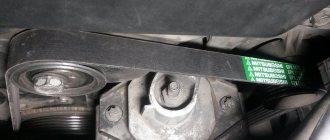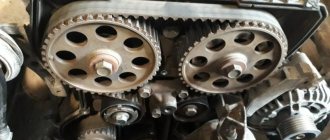Our neighbor came to us to undergo scheduled maintenance on his brand new VAZ 2170, or Lada Priora in common parlance, to replace the timing belt, pump, oil and other little things.
Different sources indicate different frequency of replacing the timing belt from 80 thousand km to 105 thousand, but we change it at 60 thousand or every four years. We check the belt tension and its condition every 20 thousand kilometers or once a year and this is not our whim, because we all know about the quality of our spare parts. When checking, we pay special attention to the absence of cracks and tears on the belt, as well as oil or antifreeze. And remember that saving on a timing belt can result in many times higher costs for engine repairs.
Important! When the timing belt on the 21126 engine breaks, all 16 valves bend.
And yet, not everyone knows, but on the sixteen-valve Priora engine, lightweight connecting rods are installed, and when the timing belt breaks, not only all 16 valves bend, but in most cases the connecting rods as well. And if they are not replaced, the car will have a decent oily appetite. Therefore, it is better to play it safe.
Together with the timing belt, we also change the pump, since in my experience most of the cases of toothed belt breakage occur due to a jammed pump.
How to replace the timing belt on a VAZ 2170-VAZ 2172?
Removal: 1) The first thing you need to do is prepare to remove the belt; preparation includes removing the minus terminal from the battery (How to remove it, read in point one “”) and installing the piston of the first and fourth cylinders to the TDC position (How to install, read the article: “Installing valve timing by marks”).
2) When all the preparatory work has been done, proceed to removing the belt itself; to do this, use a wrench or a 15-socket wrench to slightly loosen the tension on the tension roller (the roller mounting bolt is indicated by a red arrow, just do not confuse the tension roller with the support roller, so, by the way, the support one is to the right, and the tensioner is to the left and the tensioner is attached not in the very center but slightly to the side) and then turn it counterclockwise or clockwise (Whichever you like), so that the timing belt is loosened and is no longer strongly tensioned and thereby remove the belt from all the upper pulleys on which it is located (the upper pulleys include two camshaft pulleys, as well as the pump and also remove it from the tension roller).
3) Now you will need an assistant and a large thick flat screwdriver, in general everything is done as follows, in the engine compartment you look for the gearbox, and to be more precise, the clutch housing, and this housing has a small hole that is closed with a rubber plug, assistant let him pull out this plug and then insert a screwdriver into the teeth of the flywheel, thereby securing it from turning, at this time you completely unscrew the bolt that secures the crankshaft pulley and the generator pulley (the generator pulley is the one that is large, the crankshaft is the one that is small) and how Once the bolt is unscrewed, remove the generator pulley from the car and the washer located behind it.
Note! Also, don’t forget to remove the generator belt from the pulley, otherwise it will greatly interfere with removing the pulley. For information on how to remove it, read the article: “”!
4) And finally, at the very bottom, remove the belt (Indicated by the arrow) from the crankshaft pulley, but only remove it carefully, without turning the pulley, and in general, when the belt is completely removed, you do not need to turn any pulleys, otherwise if with force turn the camshaft pulleys, for example, provided that the first and fourth cylinders are set to the TDC position, then a meeting of the valves with the pistons may occur, due to which either the valves or the pistons (which is very unlikely) may be slightly deformed, so turn There is absolutely no need for any pulleys after removing the belt, but if you still twist them a little, then carefully return them to their place.
Installation: 1. When you install the new belt, clean all the pulleys and tension roller from dirt and after cleaning, degrease them with white spirit, or just go over them with white spirit right away and that’s it, and by the way, when installing the generator pulley, make sure that The pulley groove (Indicated by the red arrow) falls on the crankshaft pulley boss (Indicated by the blue arrow), otherwise you will not install the generator pulley.
2. After all the operations performed and most importantly after installing the new belt, adjust it, it is adjusted by the tension roller, namely, take a special key or a circlip puller (the puller is used in the photographs) and use it to clamp the outer disk of the tension roller (There are grooves will be, it will be necessary to insert a key or a puller into these grooves) and after which the roller is rotated counterclockwise (see photo 1), until the cutout on the outer disk with a rectangular protrusion on the inner sleeve of the tension roller coincides (see. photo 2), after matching with a wrench, the roller mounting bolt is tightened with a torque of 33.2-41.2 (3.40-4.20) and the operation of the roller and the belt tension are checked, the operation of the roller is checked as follows, you will need to start the car and if you hear noise from the tension roller, there is a possibility the fact that the roller (namely its bearing) has failed, if this is the case for you, then remove the roller from its place and check the operation of its bearing with your hands, to do this, turn the roller bearing and if it sticks, it has axial play will be present or traces of lubricant leakage from the bearing will be noticeable, then in this case replace the tension roller with a new one, it is replaced with the belt removed, just when removing the timing belt, you will not need to loosen the roller mounting bolt, but completely unscrew it and remove the tension roller from car (see photo 3), when installing a new roller, make sure that the roller disk with markings (see photo 4) is directed not inward, but outward.
Additional video: You can see in more detail how to replace the tension roller on a car in the video below:
Tensioning the alternator belt in a Priora car - nuances of implementation
Any car enthusiast knows that there will definitely come a time when you need to tighten the Priora alternator belt. It is known that the belt drive of this car is quite durable, but during operation there is a slight stretching of the belt itself, as well as a decrease in the adhesion of its surface to the pulley and roller.
Literally as soon as you notice a whistling alternator belt on a Priora, you need to start tightening it at the same moment, especially since this is not difficult to do.
Before tensioning the Priora generator belt, you need to prepare an open-end or socket wrench for 19 and a special two-end tension wrench directly for the roller. This key is similar to the one used to change discs on an angle grinder.
What is a timing belt
This is the connecting part that ensures the synchronization of two vehicle components - the camshaft and crankshaft. However, the belt not only combines these two mechanisms, it is also connected to other parts, as a result of which a huge load is placed on it.
Due to this load, it is subject to wear and therefore must be replaced after the expiration date. If you neglect the recommendations specified in the Priora instructions regarding regular replacement, the belt will break and all the mechanisms associated with it will fail.
Untimely replacement will cost the car owner too much; it is advisable to constantly check the mechanism for damage and the first signs of wear.
It is made of high-quality and durable rubber, smooth on top and serrated on the inside. The teeth provide the strongest grip on the gears. If, due to a long period of use, parts of the teeth fall off, the car may not even start due to the fact that the automobile oil is untimely or incorrectly supplied to the cylinders located in the engine.
A simple rubber component plays an important role in the entire mechanism of the machine. Try not to forget about checking it, because a problem detected in time will save money spent on repairs.
TENSIONER FOR PRIORA AND KALINA NOT EQUIPPED WITH OPTIONS
On the Priora, which does not have power steering or air conditioning, the belt is much shorter. It works on only two points: the crankshaft pulley and the generator pulley. The latest samples are equipped with a tensioning system similar to the VAZ Kalina. That is, if on other VAZ cars the tension is done by moving the generator itself, then on the Priora, a plastic roller of the tension system presses on the drive from above. A special tensioning mechanism is installed to move the roller. It consists of several parts:
The entire system is clearly visible in the photo. To adjust the drive and replace the tensioner, the following keys are needed. Slip on 19, end and socket on 13 and any wrench on 8. First, loosen the bolt and nut holding the movable platform with the roller with a wrench on 13. Then release the lock nut securing the adjusting rod using a wrench on 19. Using a wrench or socket on 8, unscrew the adjusting rod cravings The generator remains motionless. When the belt is loose, unscrew the bolt with the bushing on which the desired part is attached. Now remove the roller and install a new one in its place.
Check the free rotation of the tensioner for the generator drive and, having tightened the rod to the normal state of the drive, securely fix all the fasteners.
Types of timing drive checks
In the absolute majority, the Priora is equipped with a VAZ 2170 engine. It has 16 valves. But there is a small part of these cars equipped with an 8-valve engine. For the most part, these are “Priors” for official use. Therefore, the 16-valve engine will be considered in the article. There are 3 ways to check belt tension:
- Organoleptic (manual).
- Using mechanical devices.
- Electronic sensor.
They will now be described in order of priority.
Manual way to check the tension and condition of the drive
This is the simplest method suitable for every owner. Although many repairmen often use it too. It's done like this. Using a #5 hex socket, remove the bolts securing the upper timing belt cover. There will be access to the camshaft gears and the belt section between them. Take the belt by the sides and try to turn it out with your fingers. The edge of the belt should move no more than 2-3 millimeters. If more, you need to tighten it. Carefully inspect the drive for cracking of the rubber. Make sure there is no fraying of the cord. No fraying at edges. If there is no damage, tighten the belt to normal.
It is recommended to inspect and check the condition of the timing drive at least every 3,000 km.
Mechanical testing method
For this you will need a special device. Dynamometric. This is a device with a scale that allows you to determine the deflection of the belt. It has its own instructions for various car models. There is no particular point in buying it for a private owner; it is suitable for small service stations.
Electronic verification method
This is the most accurate of all types of checking the Priora timing belt tension. But it requires a special ultrasonic indicator. The device is quite expensive, but convenient and easy to use. It is made in the form of an oblong rectangular case. Two wires come out of it at one end and are attached to the car battery terminals. They are designated “+” and “-”. In the middle, on one side, there is a digital window - a display. When connected, two “0”s are displayed there.
Tensioning the alternator belt: a guide for car enthusiasts
The distinctive features of the Priora from previous modifications of the manufacturer are noticeable immediately, literally as soon as we open the hood. Here the new owner of the Lada will have to learn a lot again. This seemingly not very complicated procedure, which allows you to tighten the alternator belt in a Priora car to the required limit, will require considerable effort.
The peculiarity of new car models is that the ability to choose a car equipped with optional equipment is already present as standard. So in the “base” “Priora” can already be equipped with power steering or air conditioning.
Naturally, driving the car becomes even more convenient, but the recompense for comfort in this model is a more complex design of the generator belt drive. After all, the belt itself on a Priora car, which has air conditioning or power steering, is significantly longer, has a more complex trajectory, is serviced and replaced according to completely different rules.
Replacing rollers and timing belt: step-by-step steps
Initially, it should be noted that owners of a Lada Priora car with air conditioning will need to perform some steps to get to the timing mechanism. If you have a Priora with air conditioning, then initially you need:
- Using a wrench with a 15mm head, unscrew the generator tensioner pulley (not to be confused with the timing belt tensioner pulley). If the roller is humming, it is also recommended to replace it.
- After this, remove the alternator belt, which is also recommended to be replaced simultaneously with the timing belt drive.
- Now you will have access to the protective covers of the gas distribution mechanism.
Replacing the timing belt on a Priora 16 valves with your own hands is done by performing the following steps:
- Using a hexagon or T-30 bit in the shape of an asterisk, you need to unscrew 5 bolts securing the upper cover (plastic casing) and 2 bolts of the lower timing cover.
- The crankshaft sensor is disconnected by disconnecting the corresponding chip near the upper timing cover.
- Place a jack under the wheel on the passenger side, then lift the car and hang the wheel. This must be done in order to be able to align the marks of the camshaft pulleys. This procedure can also be performed by rotating the crankshaft pulley with a key to “17”. The photo below shows marks 1 on the mechanism body, as well as marks 2 on the camshaft pulleys. They must be combined by rotating the wheel with 5th gear engaged. If you do not plan to change the pump, then there is no need to loosen the camshaft pulleys after setting the marks.
- After the marks are set, do not forget to put the gear shift lever in the neutral position. This is necessary so that the marks do not go astray.
- Checking the marks on the flywheel gear. There is a rubber plug at the top of the flywheel that should be removed using a screwdriver. Under the plug is the flywheel crown along with a mark that should coincide with the triangular mark on the left side.
- If you plan to replace the pump, then at this stage you need to loosen the fastening of the 2 camshaft pulleys. The fastening is loosened in order to subsequently avoid bending of the valves when the timing belt is removed. In this case, the bolts are loosened, but not removed.
- To gain access to the crankshaft pulley, which is located at the very bottom, you need to remove the wheel or turn it all the way to the right.
- The 5 bolts securing the mudguard are unscrewed, which is necessary to gain access to the crankshaft pulley.
- To unscrew the crankshaft pulley mounting bolt, you need to ask an assistant to engage 5th gear and press the brake pedal. At this moment, use a wheel wrench or a ratchet with a 17-mm head to apply force to unscrew the bolt. To unscrew the crankshaft pulley mounting bolt, you must rotate the key counterclockwise.
- Behind the crankshaft pulley there is a thrust washer, which also needs to be removed.
- Next, using a wrench with a “15” head, unscrew the bolts securing the rollers: tensioner and thrust.
- After dismantling the rollers: tensioner and thrust, you can remove the timing belt.
- If you need to replace the pump, the internal protective casing is removed to do this. To do this, remove the camshaft pulleys, the fastenings of which were previously loosened. After this, the three bolts securing the generator tension roller holder are unscrewed. To remove the casing, you need to unscrew 6 more mounting bolts to “10”, two of which are located behind the camshaft pulleys. The photo below shows the location of the bolts that need to be unscrewed to remove the casing. This is only done when the pump needs to be replaced.
- The inner casing is removed.
- To remove the pump, you need to unscrew the 3 mounting bolts. To unscrew the bolts you will need a 5mm hexagon. Now the pump is removed, just don’t forget to drain the coolant first.
- The removed elements should be installed in the reverse order of removal. Before installing the pump, you need to install the gasket, having previously lubricated it with a high-temperature resistant sealant. When tightening the pump mounting bolts, do not use much force to avoid stripping the threads.
- New rollers (tensioner and thrust) are installed. The tensioner roller is not tightened, as it will be used for adjustment. The camshaft pulleys are installed in place, and finally the crankshaft pulley.
- A new belt is put on. To do this, you must first put it on the crankshaft pulley, then on the pump, and finally on the camshaft pulleys.
We proceed to the procedure for adjusting the tension of the belt drive.
Checking and adjusting the tension of the timing belt.
If you want your belt to last long and trouble-free, it is important to maintain its tension in the correct position. To do this, periodically test the tension. Pay special attention to the first tension of the new belt. If the belt is loose, the lateral load on the teeth increases, which greatly accelerates their wear. In some cases, if the belt is very loose, there is a high probability of the belt teeth moving relative to the pulleys. This can lead, at best, to engine instability and loss of power. In the worst case, it will lead to expensive repairs. To check the tension, perform the following steps:
1. Unscrew the 5 bolts securing the protective timing cover and move the cover to the side.
2. Press the timing belt exactly in the center between the camshaft pulleys with a force of 100 Newtons (10 kgf). The belt deflection from the horizontal position should be no more than 7 millimeters. Modern tension rollers are also provided with a tension control mechanism. To check the quality of the tension, make sure that mark A on the outer part of the roller coincides with protrusion B.
3. To adjust the tension, slightly unscrew the roller mounting bolt and, rotating the roller, achieve complete alignment of the marks described above (see figure)
4. Secure the tension by tightening the roller mounting bolt.
5. Reassemble all remaining parts in the opposite order of removal.
Source
Checking the condition of the belt
The inspection regulations for this unit require an inspection in a cold engine state. Remove the outer protective casing to allow visual contact with the surface of the gas distribution unit parts. Having gained access directly to the timing belt, rotating its drive, inspect both sides of the consumable in detail for the presence of any kind of defects (wear, broken teeth, protruding cord, rubber delamination, etc.). Tensioner rollers are subject to careful inspection; in the presence of mechanical damage and large play, they contribute to increased wear of the consumables. The presence of oil stains on the surface of a rubber technical part, which contribute to the destruction of its structure, is not allowed. If found, immediately remove from surface.
Any auto mechanic will explain to the motorist that the timing belt must be changed regularly, otherwise its rupture during operation will damage the vehicle. All motorists will be able to replace the part if they carry out the preparatory stage correctly, remove interfering components for a while, and set the timing marks on the Priora.
Experts advise checking the condition of this component of the mechanism every 105 thousand kilometers traveled. It will be useful for motorists to learn how to disassemble the mechanism and check for damage to the belt.
How to choose a belt for Priora?
In order for the gas distribution mechanism to work reliably on the 16-valve Lada Priora 21126 engine with or without air conditioning, you must choose the right product. You can purchase a factory version; according to owners’ reviews, it is considered the best for VAZ cars. Below we will analyze the types of timing belts by size, markings and prices.
Timing belt size for Priora
For Lada Priora cars, the length and overall size of the strap depends on the number of teeth installed on it. You can accurately determine which timing belt is installed in your car by identifying the engine modification and reading the user's service manual. Or you can remove the old belt and measure its size to purchase a new one.
Straps that can be used in Prioras:
- with 111 teeth, the width of such products is 19 mm, installed on Prior engines from VAZ 2108;
- with 137 teeth, the width of such straps is 22 mm, they are mounted on engines 21126 and have article number 137-22 HNBR.
Company and prices
The brand of the company plays an important role. When deciding which timing belt for Priora 16 cl. It’s better to choose, most consumers prefer the originals.
Below is a list of timing belts for the VAZ Priora with their cost:
- The original strap is produced by AvtoVAZ, its average cost is about 1800 rubles.
- The product is from the manufacturer Gates, the cost varies around 1,500 rubles. If you want to buy a complete repair kit, it will cost the buyer approximately 3,500 rubles.
- Daiko, the cost of such a product is about 1,400 rubles.
- On average, a Kontitek belt will cost the buyer one thousand rubles.
- Products from the manufacturer Bosch have proven themselves to be positive. Their cost on average is about 1200 rubles.
- One of the most budget options is the Lynx strap; it will cost the buyer approximately 700 rubles.
The “techno-056” channel provided a video that describes all the differences between original Gates timing belts and fakes.
When to change: consequences of untimely change
It is recommended to replace the timing belt on a Priora after different periods of time. The manufacturer claims that it can withstand one hundred thousand mileage, but experience shows that a change may be needed much earlier.
The optimal period is every fifty thousand kilometers. Some argue that over such a short service life, rubber is simply not capable of failure. However, no one takes into account the conditions - roads, fuel quality, etc.
Also, during the operation of the mechanisms, it wears out, the rubber stretches, and therefore does not provide the correct tension of the timing belt, and slippage is possible. The teeth can wear off - because of this, traction with the gears is not ensured.
There is no exact time for a change that would suit all motorists. Some take good care of their vehicles, drive carefully, and use only high-quality fuel. Others use a more extreme type of driving, foreign liquids get on the rubber, etc.
In order not to lose your car during the repair period and not to spend a fortune on restoring the mechanics, write down or remember the date of the last timing belt change on the Priora. Next, regularly check the condition of the rubber; if worn, replace it with a new device.
Signs of possible failure
There are several characteristic signs that should alert the driver:
- When the engine is turned on, extraneous noise occurs. Sometimes drivers confuse a timing belt malfunction with a poorly functioning tension pulley.
- If the color of the exhaust gas has changed.
- The engine doesn't start well.
- An unusual vibration is felt.
Pay attention to these “symptoms”, even if the Priora’s mileage with a new timing belt has not yet reached 50 thousand km
It may fail earlier if foreign liquid gets onto the drive - oil, coolant, as well as dust or dirt.
It’s worse if it’s the coolant that gets onto the drive. Firstly, this means that the gasket that ensures the pump is sealed has failed, or there is a problem with the pump. Then the rubber is damaged and service life is reduced tenfold.
Even if the belt is new, but coolant or antifreeze gets on it, it will fail even after operating for 10 thousand miles. You will have to replace the Priora timing belt and figure out why foreign substances get on it.
How to check the serviceability of the belt yourself
If you suspect that it is time to replace the Priora timing belt, it would not hurt to check the serviceability of this rubber product. Visual diagnostics will allow you to check the serviceability and absence of scuffs on the Priora timing belt.
You should have a choice of one of the tools at hand, or two at once - a 5-point hex key, or a T-30 sprocket bit. If one doesn't work, try the second.
- Open and lift the hood.
- You will see the front panel covering the mechanism and timing belt.
- Take the key and unscrew the five bolts that hold the front panel, remove it.
- In front of you you will see a mechanism, including a tension roller.
- Place a jack on the passenger side and place the wheel in a suspended position. Engage fifth gear while it is working, look at the surface of the belt for damage, even small defects.
- If you notice cracks of any size, mechanical cuts, or threads sticking out, be sure to replace it by contacting a specialist or yourself.
- Check the pump. If any traces of coolant leakage from the pump are noticeable, then the rubber will also have to be changed, even if there is no mechanical damage.
- Check the tension roller. Auto mechanics advise changing it less often than tires. The average lifespan is approximately one hundred thousand kilometers. Change it every other time you change the belt.
- Measure the belt tension. To do this, press on the stretched rubber in the area between the gears of the two camshafts. You need to press with a force of about ten kilograms. Correct tension of the timing belt should not bend more than seven millimeters.
- Check that the rubber is not too loose. Make sure that the Priora timing marks match the original condition. The first, similar to a recess, is located on the outer race of the tension roller. The next one is located at the base of the roller. The maximum deviation is four millimeters; if the tension does not meet the standards, the product will have to be changed.
Found a discrepancy with the standards? Change the product. A belt set with rollers for the Priora 126 engine costs only five thousand rubles. This is a much smaller amount than the cost of a major repair if a component ruptures.
About the resource
Well, now we’ve come to the most interesting thing, namely the resource. You know, now I want to talk specifically about normal belts and tensioning equipment, about “PRIORS” will be a little lower.
Not all manufacturers strictly indicate how often to change the belt, but such information can still be found, even in the car’s operating books.
The average mileage recommended for replacement is 100,000 kilometers. On many foreign cars, this mileage can be much longer, about 150,000 kilometers.
Now the question may arise: what does it depend on? Guys, to be honest, the belt itself can run (as some manufacturers claim) about 200,000 km, but its service life is reduced due to tension and support rollers. They are often the culprits of the cliff!
The support roller is a kind of bearing on which the belt rests, often has a plastic housing.
The tension roller is almost the same plastic bearing, only it is located on a special mount that “tensions” the belt, that is, it keeps it in “tone” and prevents it from “sagging” and jumping onto a tooth.
Both videos must be of simply excellent quality, no, they simply must! With foreign cars this is almost always the case, these “support” and “tensioner” last a long time, and replacement is 100 - 150,000 km in advance.
As you may have guessed, not only the belt is changed, but also the tension and support rollers - THIS IS MANDATORY, REMEMBER THIS! As an indirect reason for a future replacement, there may be noise from the timing drive; when the rollers begin to “bend”, they begin to make noise.
Camshaft marks
The VAZ 21126 engine uses two switchgears. One of them is needed for optimal operation of the intake valves, and the second is installed in order to regulate the movement of the exhaust valves.
Each camshaft has its own pulley, which is not recommended to be replaced with another. This pulley allows the camshaft mechanism to operate correctly. A phase sensor is installed on the right side of the pulley.
The marks are located on the pulleys. They are located on the crown of the ledge at the bottom. Experienced mechanics call them movable because they move with the rotation of the camshaft.
Attention! Beginning car owners should remember that the marks have different sizes. It all depends on the manufacturer who made the pulley
To see the marks, experienced mechanics advise wiping the pulley with a clean rag to get rid of dirt and dust. Then you will notice a small notch in the metal.
But the crankshaft marks will help all parts of the 126 engine from the Lada vehicle work equally. At the output of the crankshaft there is a gear. And this gear is connected to the device by means of a key. This is where the mark for correct installation of parts is located. Because if the position is incorrect, the key simply will not fit as expected.
The notch is made in the form of a slot or a conical hole. It is found on the outside of the engine pulley.
Additional guidelines are also applied to the outer engine housing so as not to make mistakes when setting marks. To do this, install another mark on the rear side of the timing belt housing. It is needed for the correct alignment of the camshaft pulleys.
Similar article Engine for Niva from a foreign car without modifications
Another notch is located on the engine oil pump. It is needed for the correct orientation of the crankshaft. And it will be difficult to find the last mark. It is located on the flywheel.
There is a small cutout in the flywheel housing. According to the standard, it is covered with a rubber plug. It is pulled out and inserted with pliers.
How to replace the Priora timing belt
So, having selected a suitable timing belt for the Priora (regardless of the manufacturer, it is important to select a 16-valve Priora timing belt), you can begin the replacement procedure. The width of the belt should be 22 mm, the number of teeth is 137
After removing the timing cover, you must first align the timing belt itself. To do this, the crankshaft and camshafts are placed at TDC on the compression stroke of the first cylinder.
To rotate the crankshaft, use a 17mm wrench to turn the bolt securing the auxiliary drive pulley clockwise until the marks on the camshaft toothed pulleys align with the marks on the rear drive cover.
Also, to check the position of the crankshaft, you need to remove the plug from the rubber (it is located on top of the clutch housing). The mark on the flywheel should be opposite the slot in the upper cover of the clutch housing.
Then you need to fix the crankshaft. To do this, when unscrewing the bolt securing the drive pulley of the mounted units, you should invite an assistant to engage 5th gear and press the brake.
Now the pulley can be removed, and the washer is removed in parallel. To make it easier to put everything back together, the camshaft pulleys can be fixed in relation to each other before removing the belt. Pre-prepared wooden pegs are suitable for this.
Wooden wedges can be lightly driven between the teeth of the pulleys. Then use a 15mm wrench to loosen the bolt securing the timing belt tension roller. The roller will turn, the belt tension will be small, which will allow it to be removed from the camshafts. The belt can now be removed from the pump and crankshaft pulleys.
It is important to ensure that after removing the belt, the crankshaft and camshafts no longer rotate, as the pistons and valves may accidentally collide!
As for replacing the timing belt, first change the tension roller, then the support roller. The rollers are removed along with the bolt and thrust washers. At the same time, you need to check the condition of the pump
It is important that there are no leaks of antifreeze, the pump shaft should rotate easily, there should be no backlash, etc. If the pump is not working, it also needs to be replaced
By the way, before installing new timing belt rollers on the Priora, the threads of the mounting bolts should be coated with a special fixing sealant. Also, the support roller mounting bolt can be immediately tightened (torque 34–41 Nm), while the tension roller mounting bolt should not be fully tightened at this stage.
Next, you can proceed to installing the timing belt.
Before installing it, it is important to check that the camshaft timing marks match the marks on the rear drive cover. If the accessory drive pulley is removed, in this case it is easy to determine the position of the crankshaft (the marks on the crankshaft toothed pulley must coincide with the mark on the oil pump cover)
Now all that remains is to put the timing belt on the crankshaft pulley. The main thing is to tension both parts of the belt, placing the front part behind the support roller. At the same time, the rear part is put on the pump pulley and pulled behind the tension roller. Then you can put the belt on the camshaft pulleys. If the pulleys were previously secured, all stoppers must be removed. You can then adjust the timing belt tension as described above.
The final stage is the installation of the drive pulley for the mounted units. After this, turn the crankshaft by the pulley mounting bolt 2 turns clockwise. Next, you should check that the marks on the crankshaft and camshafts match exactly, and that the belt itself is tensioned properly.
If deviations are noticeable, the entire adjustment and/or installation process should be repeated. If the marks coincide, you can completely tighten the tension roller bolt (torque from 34 to 41 Nm), as well as the attachment drive pulley bolt (bolt tightening torque 105 or 110 Nm).
Necessary tools for replacement
Having decided that you need to replace the timing belt on a Priora, you should prepare the necessary material and tools. The materials will require a new timing belt. Moreover, you can buy both the original belt and analogues. The original belt product is also equipped with two rollers: a tensioner and a thrust roller. The cost of such a kit is about 5 thousand rubles.
Original kit for timing system on VAZ-2170
If necessary, you should purchase a new pump if the car’s mileage exceeds more than 100 thousand km and the product has never been changed. If you are replacing the pump, you will also need to replace the coolant.
This is interesting! Antifreeze needs to be replaced every 2 years, and antifreeze every 4-5 years.
Of the tools to replace the timing belt on a Lada Priora, 16 valves will be needed:
- Head at "17".
- Set of open-end wrenches.
- Screwdrivers.
- Hex key or T-30 sprocket, depending on the year of manufacture of the car.
- Special key for adjusting the roller. Comes with a set of belt and 2 rollers.
It is not necessary to install the Priora in the inspection hole, since most of the actions will be performed in the engine compartment. Once all the tools and materials are ready, you can start working.
How to check tension
At the end of the work, it is necessary to adjust the tension of the timing belt drive on the Priora. The adjustment is made as follows:
- Using a special wrench, you need to turn the tensioner pulley counterclockwise.
Tensioner adjustment key
- Align the marks on the roller as shown above, and then tighten the fastening bolt.
- Rotate the crankshaft pulley 2 turns by the mounting bolt in a clockwise direction. At the same time, the coincidence of the marks on the camshaft and crankshaft pulleys is checked.
You can check the tension by applying force to a rubber product weighing 10 kg. The deviation value should not exceed 5-7 mm.
When tightening the pulley and roller bolts, it is recommended to use a torque wrench. The tightening torque for each element is equal to the following values:
- for the tension roller – 35-41 Nm;
- thrust roller – 105-110 Nm;
- pump mounting bolts – 15-20 Nm.
After adjustment, you can put the protective cover back in place. Finally, the generator belt tensioner roller is installed, as well as the belt itself. It is also recommended to replace these elements with new ones. Finally, do not forget to fill the coolant before starting the engine.
Upon completion of the work done, you can start the engine and check its operation. If the marks are correctly set, the engine will start the first time the key is turned in the ignition switch. In this case, the engine should operate evenly and keep the speed in the region of 800-900 rpm. Listen to the timing belt drive. There should be no extraneous sounds or noises. The presence of a whistle or hum indicates that the tensioner is too tight and needs to be loosened.
Video: replacing the timing belt and rollers with a pump on a Priora VAZ 2172, 2170, 2172 (timing marks)
In conclusion, it should be noted that the process of replacing the timing belt on a Lada Priora car does not present any difficulties if all steps are performed one by one. Even an inexperienced driver can handle this procedure, so don’t be afraid when the time comes to replace the belt product.
- Author: Andrey
Rate this article:
- 5
- 4
- 3
- 2
- 1
(28 votes, average: 4.2 out of 5)
Share with your friends!
Home →
Maintenance and Repair →
Engine →
Consequences of a cliff
Broken timing belt
As a result of a broken timing belt, the valves are the first to suffer. When it breaks, the camshafts stop rotating, therefore, the valves freeze in place.
Bent valves
The crankshaft has more mass and continues its rotation by inertia, pushing the pistons along the cylinders. When the piston reaches TDC (top dead center) and the valve remains open, the piston hits it with such force that it bends the valve and in some cases breaks itself.
Broken piston
A piston break can lead to scuffing of the block mirror, which will lead to quite expensive repairs. Consequently, after the belt breaks, the car will no longer be able to move under its own power. The cost of repairs reaches 50,000 rubles.
